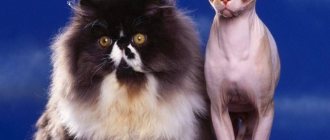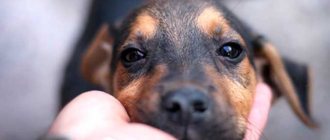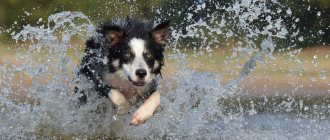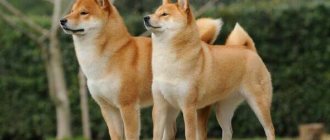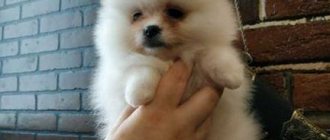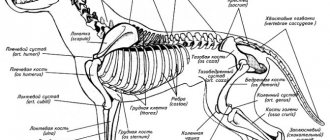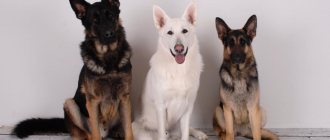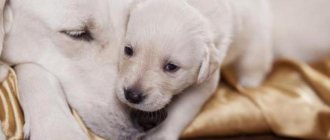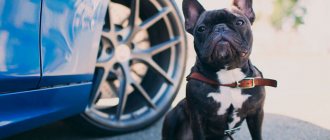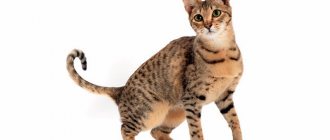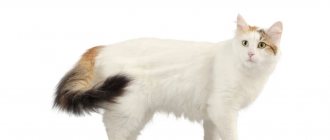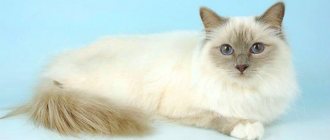How to determine a dog's breed from a photo
All advertisements for the sale of dogs online are accompanied by photographs, sometimes very attractive ones. It seems that here it is, a long-awaited dream, looking at you from the next photo with such touching eyes. Should we trust this photo?
It is almost impossible to accurately determine the breed of a dog from a photo. Provided that there is no information about the pedigree and scanned documents are not provided. Not only because an unscrupulous seller can change the picture presented on the Internet on a bulletin board using Photoshop. The fact is that the text of the advertisement usually does not publish those exterior parameters that are required to determine purebredness.
These are, for example, height, weight, chest volume, body length from withers to tail, etc. In addition, each breed has its own unique international standards. Only a specialist who deals specifically with this or that breed group knows all the nuances.
Even a highly qualified professional is not able to say specifically by looking at a photo of a dog. He can only state that this animal is more or less similar to one or another breed. It will be difficult to judge how well the dog’s appearance corresponds to the standard.
In addition, not everyone has the opportunity to find such a specialist. However, there is a resource on the Internet that helps, not exactly, but still determine from an online photo whether a dog may belong to a certain breed. This resource should be perceived rather as a game and the information it provides should not be considered thorough.
This is the site https://www.what-dog.net. Here you can upload the selected photo and get the result automatically.
The technology consists in the fact that a computer program recognizes the type of animal by the location of the eyes, the configuration of the nose, and the ears of the dog depicted in the photograph. However, the camera can somewhat distort the real appearance of the pet. After all, it is proposed to use a webcam for photography, which, especially, cannot be compared in terms of the quality of the resulting images with a good camera. Therefore, the result is unlikely to be reliable.
other methods
By photo
The Internet offers specialized online services that determine the breed of a dog based on a photograph of the pet:
- https://www.bing.com/visualsearch/Microsoft/WhatDog;
- https://poroda-sobaki.by-photo.net/;
- https://www.proandroid.net/software-3659-magic-dog.html.
According to the test
The service allows you to determine the breed of a dog by verbal description. This is necessary, for example, if there is no photograph of the animal. In fact, the service helps to draw a conclusion based on the data collected by the owner and measurements of the pet:
A new service offered by veterinary clinics is DNA testing to determine the breed. Let us note the disadvantages of this method:
- high price;
- a small database of samples for comparison, since the service is new;
- the result is not always reliable due to the presence of “impurities” in the selection.
Brand
It is easier to get information about a dog if there is a readable brand. To do this, contact a cynological organization, which one is determined from the RKF stamp database:
Expert help
A veterinarian or dog handler can provide primary assistance in determining the breed. To confirm your guesses, you can contact a breed expert - in a club or nursery, talk with a breeder, or discuss the situation on an online forum.
By puppy
Any dog specialist will tell you that it is impossible to determine the breed of a dog by looking at a puppy, especially a newborn. After all, puppies change literally every week and grow. Not only the length of the paws or the set of the ears may change, but even the color.
For example, Yorkshire terriers are short-haired and brown in color when they are puppies. And when they become adults, their fur becomes long and on the back it can acquire a special bluish tint.
There are so many cases when you purchased a seemingly purebred puppy, but something unimaginable grew up. Only vaguely similar to a representative of the chosen breed.
The only criterion is to purchase a puppy from a reputable breeder who cares about the preservation and dissemination of the breed, and is not just busy with personal enrichment. Documents must be in order and not fake. You should also look at the parents of your future pet to make sure of the integrity of the breeder.
How I was offered to breed “pedigreed Chihuahuas”
Mixed dog and chihuahua
I had a curious incident. I was walking with my dog Zosya, a lapdog, along the street. A certain citizen approached us and offered to match my dog with one of his Chihuahua dogs. He, as it turns out, is a breeder and specializes in breeding “Chihuahuas,” as he put it.
He was not at all embarrassed that I asked a question about the purebredness of the puppies that would result from such crossing. He only noticed that “chihuahuas” would definitely be born, which the clients would simply tear off with their hands for a lot of money, which we would then share with him.
Naturally, I did not agree to such an adventure. I have no reason to deceive people who want to buy purebred animals, especially at a serious price. And the prospect of turning a beloved dog into a birthing machine somehow did not please me. Not to mention the fate of mixed-breed puppies.
So the breeder’s credibility, fame and good reviews from satisfied customers are practically the most important criteria for choosing a purebred puppy.
The most different puppies from adults
Here are the breeds whose puppies are completely different from adult dogs:
- The Tibetan Terrier is a small, fluffy little ball of puppy with a cute snub nose and short hair. But, as an adult, he turns into a dog with unusually long hair, which also grows on his head. Completely covering your eyes and ears.
- Bobtail - representatives of this long-haired breed, as puppies, unlike adults, have curly hair and a completely different color.
- Saluki - in childhood it is an awkward puppy, whose movements are clumsy, which causes a smile and tenderness. He doesn't even remotely resemble an adult dog of this breed. Slender, light and precise in every movement. Elegance and grace are complemented by long hair on the ears and tail that appears only after 8 months of life.
- Bearded Collie – puppies of this breed are extremely difficult to identify. These are curly fluffy balls. How they will grow up if there are no documents is completely unclear. These babies turn into fairly tall dogs with magnificent straight long hair of a peculiar double color.
- Bergamasco Shepherd - the kids are shaggy, but the hair is short and black. As they grow, these animals acquire a surprisingly long coat, which consists of three types of hair shafts. The coat grows over the course of 5-6 years until it covers the dog completely, from the top of the head to the ground.
- Otterhound – this breed cannot be identified at all in childhood. Characteristic signs appear only after growing up. These are thick eyebrows and a beard.
How can you determine the breed of a dog by appearance?
It is possible to accurately determine a dog's breed by appearance at an age older than 1, and in some cases even 2 years. The easiest way is to contact a veterinarian and do a DNA test. However, this is an expensive procedure that will take more than one day. In addition, not every city has such technology.
You can try to do this yourself, armed with a reference book describing international standards for various breeds. To do this, you will need to be patient and understand where to start and in which direction to move. First of all, you should familiarize yourself with the basics.
Absolutely all dogs can be divided into three main groups:
- Pedigree purebred breeding dogs. These animals have external characteristics that meet international standards. Data about this is contained in the passport, where the animal’s name, information about the breed, and color are recorded. The origin of each puppy is recorded in the pedigree, which indicates the so-called purity of blood. Here information is given about all his ancestors, parents, and owner. The pedigree is drawn up from 6 months of age to 15 months. Therefore, if a breeder offers to take a two-month-old puppy with a ready-made pedigree, then such a document is a fake. There may be a mark and chip on the animal’s body. Then information about such a microchipped dog can be obtained from a veterinary clinic or a kennel club. If you find a dog on the street with a “suspicious” breed, but there is no mark or chip, then you should contact a specialist, a veterinarian. He will examine her for compliance with international breed standards and the body parameters of the “foundling”.
Mixed husky and shepherd - Metis. These are animals whose parents were representatives of different breeds. Now, by the way, such “designer” dogs are in fashion. Also, pets are considered mestizos, one of whose parents was an outbred animal or the same mestizos. Typically, the “blood” of such dogs contains several genotypes at once.
- Phenotype. Even a completely purebred animal is considered such until a specialist determines that it belongs to a particular breed and records this in the passport. In this case, a specialist can say the following: “According to the phenotype, this animal belongs to the Yorkshire terrier.” In other words, all the external signs of the breed are present, but there are no documents confirming this.
- Mongrels. These are outbred animals whose origin is unknown. No external breed characteristics have been identified. There is no talk about pedigree here at all.
Methods for determining breed
For example: this is what the international standard looks like for identifying the Rhodesian Ridgeback breed by appearance.
There are many standard criteria that correspond to the characteristics of a particular breed. However, it is worth familiarizing yourself with the main ones in more detail.
Age
Any specialist, when beginning an examination of an animal, first of all pays attention to its age . Because it is necessary to understand whether the animal in front of him is an adult or a puppy.
Age is usually determined by teeth. Here the reliability is not very high if the dog was picked up on the street. After all, even a puppy, as a result of a difficult life, may have worn-out teeth and are not at all in the same condition as those of a baby born in favorable conditions, in a family or in a nursery.
Size
Then they begin to examine the body to determine the main parameters. One of the main ones is the size of the dog:
- Dwarf breeds - weight up to 5 kg in adulthood, height no more than 30 cm at the withers.
- Small breeds - weight from 5 to 12 kg, height from 30 to 40 cm.
- Average - weight, respectively, from 12 to 22 kg, height from 40 to 55 cm.
- Large – weight from 20 to 30 kg, height – 56-65 cm.
- Very large - weight from 40 to 50 kg, height 70-75 cm.
- Giants are those that exceed the size of very large breeds.
Backbone
Belonging to a particular breed group can be understood by the structural features of the animal’s skeleton in combination with other parameters. For example, the structure of the skull - the length of the muzzle, the position of the ears. The height of the paws and their shape, etc.
- Narrow bones. Its characteristic features are a narrow, equal-width chest and pelvis. Typically, narrow bone structure is combined with other parameters. Tall, muscular, slender legs. Long, elongated muzzle. The belly is lean and the sternum is voluminous. The ribs are low, reaching almost to the elbows. In general, the constitution is dry, and the body shape is streamlined. Similar signs are characteristic of racing breeds - greyhounds and hounds. Representatives of breed groups:
- Russian Greyhound;
- Scottish Greyhound;
- English hound;
- Otterhound;
- American Bulldog;
Russian greyhound
- Medium bone. This is a wide chest and a narrow pelvis. Many breeds have this skeletal structure. Starting with the Finnish Spitz and ending with the Husky. With average bone structure, it is very important to determine other characteristics in order to establish the breed. However, typical representatives are all service dogs, including shepherds.
German Shepherd - Wide bones. A wide chest equals a powerful and heavy pelvis. Typically, this physique is characteristic of strong and muscular animals. They have large paws, a wide skull, powerful jaws, a strong nose with large nostrils. Here are the typical breeds:
- Alabai;
- Labrador;
- Rottweiler;
- Mastiff;
Alabai
- Shortened bone. Usually the body of such dogs is square. The hind legs are slightly shorter than the front legs. Such animals often have a not very long, or even short, nose. As an example - Pekingese, Spitz. Most often, dwarf and small breed animals have a shortened bone structure.
Pekingese
Other characteristics of the breed
Important features that are found in international breed standards that you should pay attention to:
- Posture. Representatives of different breeds may have different back slopes: downward, inclined, straight. For example, according to the standard, German Shepherds must have a back tilt of 20 degrees. If the back is sagging, this is not a feature of the breed at all, but a sign of disease or a developmental defect of the animal.
- Head. All the smallest details are taken into account here, including its size, various details of the shape of the skull, the transition from the forehead to the nose, the development of the jaws, the ratio of the skull to the facial part as a percentage, the shape of the back of the nose, lips, etc.
- Ears. They can have different sizes and shapes, as well as fit. Ears can be erect, semi-erect, drooping, or cropped.
- Teeth. Different breeds have their own dental formulas and bite types.
- Eyes. Eye color, shape, cut, fit and even look are assessed. German Shepherds, for example, have a piercing gaze. The color of the eyelid and the fur around the eyes also matter. Colored lap dogs should have their eyes lined with black pencil, just like human fashionistas do.
- Neck. It can be long, short, wide and thin. Even the angle of its inclination in degrees relative to the horizontal of the back is taken into account.
- Tail. The variety here is incredible. Take into account its length, position - above the spine or below. Straight or curly, coarse or silky long coat, fluffy or short coat, docked or not.
- Paws. The fore and hind limbs are considered separately. The parameters here are complex, there are many of them. There may be requirements for the angle of inclination between the scapula and the humerus. The relationship of the forearm and metacarpus, the angle of their location in relation to each other. The angle formed by the thigh and shin. The location of the elbows, the shape of the toes, pads. The condition of the joints and much more, say, the color of the claws.
- Leather. It may lie close to the body or be arranged in folds of various sizes and in certain places. In this case, the color of the nose is very important.
Wool
The animal's fur is one of the most important criteria for the breed. Here, not only its color is assessed, but also its structure.
Take a look at how a completely unique specialist, with amazing knowledge and unusual sensitivity, determines the breed of dogs by touch, by the structure of the coat. Although, keep in mind, this is just a show, and Irina Korkh does not actually establish the breed, but the phenotype:
Dogs have 5 types of coat:
- The coat is of medium length with undercoat, which is found in most animals. An example is in shepherds, pugs, and huskies.
- The coat is long, with or without undercoat. Found in Yorkshire terriers, varieties of spaniels, collies, Maltese dogs, Shitzus, Lhasas.
- Smooth coat without undercoat. Can be tough, like schnauzers. Soft - found in various terriers, pinschers, boxers.
- Curly with an undercoat that is also curled. Here you can name poodles, Lagoto Romagnolo, Portuguese water dog.
- Hairless breeds - Chinese Crested, Mexican Hairless Dog.
Yorkshire Terrier
Coat color is sometimes of fundamental importance for determining the breed of an animal. In dogs it is very diverse. Primary colors are black, brown, red. All the rest are only variants and shades , indicating the lightening of the primary colors: gray, fawn, blue, apricot, murugi, coffee.
White color is also the main color. The hairs in this case contain an extremely small amount of coloring pigment; in fact, this is albinism. However, there are no complete albinos among dogs.
The coat color of dogs may not be solid, but consist of different sections of two or more colors. Due to this, a certain pattern is formed on the dog’s body. This effect is called colorization :
- Black color - usually consists of two colors, red and brown, red and black, like German shepherds, for example, black and gray. The darker shade is usually expressed on the back, and may partially cover the ears, forehead, shoulders, hips, and upper part of the tail. For some breeds, the shades of the saddle color and its location are important.
- Tan is also bi-colored with different shades. The main background of the animal's fur is usually dark, and the tan marks are lighter. They may have a peculiar pattern, like a Doberman or Rottweiler. Located in certain places of the body.
- Wolf , zone-gray, when the hair itself is unevenly colored. The color is darker in depth, and lighter towards the top. The zone-red color is rare.
- Brindle , when quite bright stripes of a dark color are noticeable on the main light background. They can cover only certain parts of the body or the entire body. By color there are red, gray and porcelain brindle. According to the location of the stripes, it can be blurry, merged, intermittent.
- Piebald is a combination of dark and white spots on the chest, head, paws, and tip of the tail.
- Marble color - the main background is white, but throughout the body there are torn dark spots, the size of which is completely different. Smaller ones are located on the head and limbs, and larger ones are located on the body.
- Spotted color is a white background, on which there are spots of black, red or gray. They spread throughout the dog’s entire body, not only throughout the body, but also over the head, ears, around the eyes, and tail.
- Speckled color - similar to marbled, but differs from it in that the spots are small and of the same size, evenly distributed throughout the body. Typical representatives are the Dalmatian and the English Setter.
Dalmatian
It should be noted that for some breeds the combination of coat color, eyes, eyelids and nose is very important.
Behavior and character
Breeders bred different breeds of dogs not only for the sake of beauty. Man needed hunting helpers, protectors, and rescuers. Therefore, not only the appearance, but also the behavior of the animal was adjusted during the selection process. Some instincts stood out, others tried to be obscured, as if to make them less obvious. This is how the working qualities of dogs were born, which characterize a particular breed and are their distinctive features.
For example, shepherds are herding dogs. This behavior is genetically embedded in them. Having met a cow or sheep on its way, the shepherd dog will immediately take up its “responsibilities”. Her concern is to gather animals into a herd and protect them. Sometimes shepherd dogs behave the same way towards people and children. When taking care of children, the dog may sometimes even lightly nip their heels, as it does when corralling sheep.
Hunting dogs have an unusually sensitive sense of smell. They make a stance if they see prey; they have a highly developed instinct of pursuit, but at the same time they are not able to carry out security functions.
Why do you need to determine the breed?
The information you gain by researching your dog's breed will be very important for your future care and training.
Some breeds suffer from specific chronic diseases. It will be necessary to properly feed such an animal, walk it, and keep it in a certain place so as not to provoke the manifestation of the disease.
There are breeds that require special care for their coat and skin. Some long-haired animals should not have their fur cut so as to expose their eyes. For others, too short haircuts are strictly contraindicated, such as Pekingese.
Knowing the working qualities of your dog, it will be easier to learn to subdue and control it. Accustom to order and train. There will be no questions “why is she doing this, I’m shocked...” and scolding her for “wrong” behavior, from the owner’s point of view. Find the right approach to your dog so as not to cause psychological trauma to it by futilely trying to change what is in the genes.
By the way, genetically determined behavioral characteristics should always be complemented by good upbringing. You can’t leave everything to chance, because working qualities will never replace quality training.
If the dog turns out to be a mongrel mongrel, that’s not bad at all. “Door Terriers” are hardier, smarter, and healthier than purebred and purebred animals. They live longer and are unpretentious in food. They will bring as much love and joy as the most expensive purebred dogs.
The most important thing is to ask yourself why I need a purebred dog. This is a fad to make your neighbors jealous or a serious hobby to which you are ready to devote a fairly significant part of your life. Participate in exhibitions, spare no effort and money on caring for the appearance, and train your pet professionally. A dog with certain working qualities or just a cute and sweet friend is required.
When you answer this most important question, then you can choose the breed of dog for yourself.
What is a purebred dog
There are about 500 dog breeds in the modern world, and selection work with these animals continues. Depending on the degree of “pedigreedness,” dogs can be divided into 4 categories:
- Purebred (thoroughbred) animals. They are bred in nurseries, they have documents and their pedigree is known (the deeper into the past it goes, the better).
Husky is a fashionable breed that is easy to visually distinguish from a mongrel, but mixed breeds of the breed can be very similar to the original
Mixed breeds are jokingly called “designer” dog breeds for their uniqueness, because you can’t find another dog like them
Man's most loyal friends are ordinary mongrels
When buying a purebred animal secondhand, at best you can get a phenotype, and at worst, a mixed breed or a mongrel. Some buyers don't mind this because they want a dog with a certain appearance (for example, a spaniel with its beautiful coat and long ears) and not necessarily a purebred. However, in this case, no one can guarantee the buyer that the dog will have the character qualities specified by the breed, whereas in purebred animals, the characteristics of temperament and character are prescribed in the breed standard.
